冀教版英语三年级上册:Lesson17AreYouOkay教案
- 格式:pdf
- 大小:26.20 KB
- 文档页数:2
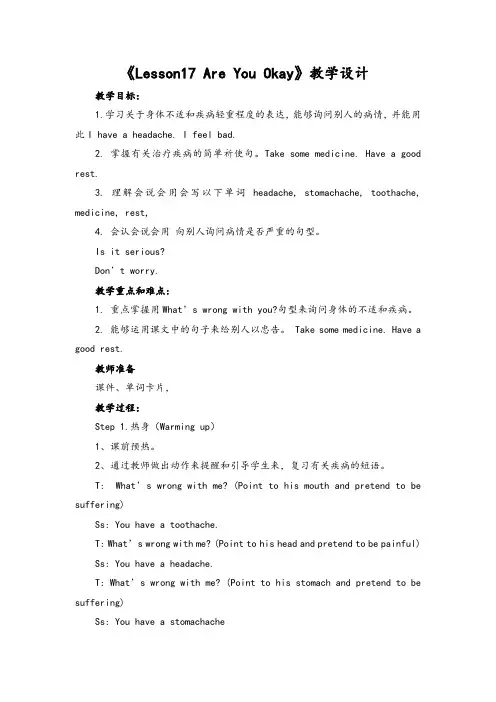
《Lesson17 Are You Okay》教学设计教学目标:1.学习关于身体不适和疾病轻重程度的表达,能够询问别人的病情,并能用此I have a headache. I feel bad.2. 掌握有关治疗疾病的简单祈使句。
Take some medicine. Have a good rest.3. 理解会说会用会写以下单词headache, stomachache, toothache, medicine, rest,4. 会认会说会用向别人询问病情是否严重的句型。
Is it serious?Don’t worry.教学重点和难点:1. 重点掌握用What’s wrong with you?句型来询问身体的不适和疾病。
2. 能够运用课文中的句子来给别人以忠告。
Take some medicine. Have a good rest.教师准备课件、单词卡片,教学过程:Step 1.热身(Warming up)1、课前预热。
2、通过教师做出动作来提醒和引导学生来,复习有关疾病的短语。
T: What’s wrong with me? (Point to his mouth and pretend to be suffering)Ss: You have a toothache.T: What’s wrong with me? (Point to his head and pretend to be painful) Ss: You have a headache.T: What’s wrong with me? (Point to his stomach and pretend to be suffering)Ss: You have a stomachacheT: You are really a good doctor.Step 2新课展示(New Presentation)1、教师对本课重点词汇和重点句型进行讲解。
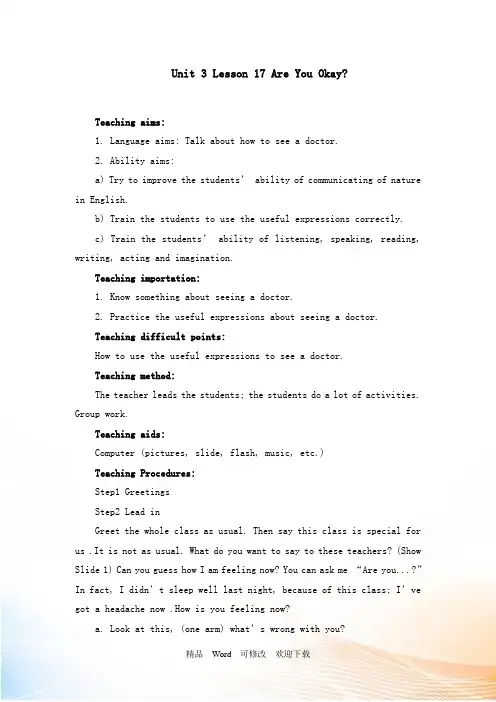
Unit 3 Lesson 17 Are You Okay?Teaching aims:1. Language aims: Talk about how to see a doctor.2. Ability aims:a) Try to improve the students’ ability of communicating of nature in English.b) Train the students to use the useful expressions correctly.c) Train the students’ ability of listening, speaking, reading, writing, acting and imagination.Teaching importation:1. Know something about seeing a doctor.2. Practice the useful expressions about seeing a doctor.Teaching difficult points:How to use the useful expressions to see a doctor.Teaching method:The teacher leads the students; the students do a lot of activities. Group work.Teaching aids:Computer (pictures, slide, flash, music, etc.)Teaching Procedures:Step1 GreetingsStep2 Lead inGreet the whole class as usual. Then say this class is special for us .It is not as usual. What do you want to say to these teachers? (Show Slide 1) Can you guess how I am feeling now? You can ask me “Are you...?”In fact, I didn’t sleep well last night, because of this class; I’ve got a headache now .How is you feeling now?a. Look at this, (one arm) what’s wrong with you?b. (head) now asks her, please.What should he do? See a doctor .That’s our today’s topic.(Show Slide 2)Step 3: RevisionToday we are going to learn something about how to see a doctor, first let’s revise some useful words about feelings of illness. (Show Slide 3)When you see a doctor , what will the doctor ask you first ?What’s wrong with you ?(another way to say this sentence ,please .) ok ,now let’s ask and answer by these pictures .(Then ask Ss to ask and answer in different ways.)Now look at me, what’s wrong with me? (Backache) I am too tired.Step 4: PresentationI think everybody has ever seen a doctor .So has Jill .Now let’s listen to a dialogue with the three questions.a .Listening by watching a short videob. Answer three questionsWhat are Jill’s feelings of illness?She has got a headache and a coughWhat does doctor do with her?He takes her temperature.What does the doctor advise her to do?Take this medicine three times a day.Have a good rest and drink more water.(Does she need to give an injection? How to take the medicine? I think you should drink more water, because it’s good for your health .ok, let’s read the dialogue carefully.)c. Language points1. How are you feeling now?2. Feel like doing sth /n.Want /would like to do sth. (Now pay attention to this sentence .who can make a sentence using it.)3. How long have you been like this?(Maybe the doctor will ask you “How long have you been like this? “How do you answer it, you may say “since last night or for two days.”) T: What’s wrong with you?S: I have a…T: How long have you been like this?S: Since last night.Step Four: Make a conclusionLet the students say useful expressions by themselves .So if you don’t feel well, you’ll see the doctor .When you see the doctor, what will he ask you?(one by one ). (Show Slide)Then let Ss read it together. How do you answer the doctor’s question? It means when you go to see the doctor, you may say: (one by one). (Show Slide)Step Five: DrillJust now, I taught how to see a doctor Do you know how to see a doctor now? Let’s make a dialogue in pairs or in groups, then act it out.Dialogue 1, Dialogue 2, Dialogue 3,Step Six: Have a matchNow let’s have a competition .Group1stands for doctors ,group 2 stands for patients .If you say a sentence ,I will give your group a big on!(wait for me ,if not ,you won’t get an apple you had better not say the same sentence..)At last, guess an old saying by a picture.(one apple a day keeps doctors away. )Step Seven: HomeworkWrite a dialogue about seeing a doctor.Writing on the blackboardSee a doctor1. How are you feeling now?2. Feel like doing sth /n.Want /would like to do sth.3. How long have you been like this?。
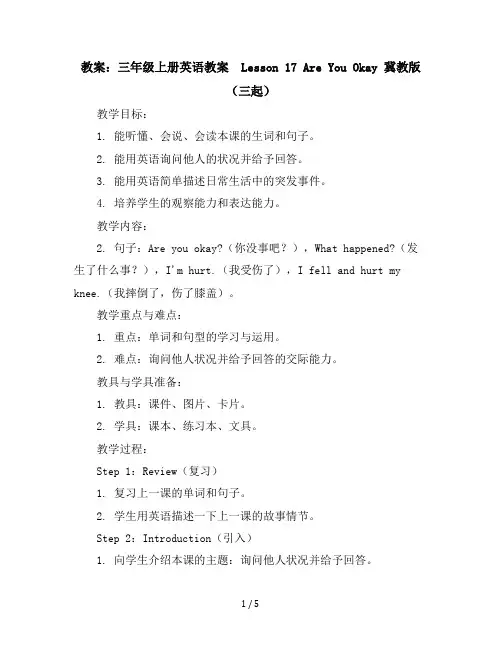
教案:三年级上册英语教案 Lesson 17 Are You Okay 冀教版(三起)教学目标:1. 能听懂、会说、会读本课的生词和句子。
2. 能用英语询问他人的状况并给予回答。
3. 能用英语简单描述日常生活中的突发事件。
4. 培养学生的观察能力和表达能力。
教学内容:2. 句子:Are you okay?(你没事吧?),What happened?(发生了什么事?),I'm hurt.(我受伤了),I fell and hurt my knee.(我摔倒了,伤了膝盖)。
教学重点与难点:1. 重点:单词和句型的学习与运用。
2. 难点:询问他人状况并给予回答的交际能力。
教具与学具准备:1. 教具:课件、图片、卡片。
2. 学具:课本、练习本、文具。
教学过程:Step 1:Review(复习)1. 复习上一课的单词和句子。
2. 学生用英语描述一下上一课的故事情节。
Step 2:Introduction(引入)1. 向学生介绍本课的主题:询问他人状况并给予回答。
2. 展示图片,引导学生用英语描述图片内容。
Step 3:Presentation(展示)1. 教授本课的生词和句子。
2. 学生跟读,模仿语音语调。
Step 4:Practice(练习)1. 学生分组,进行角色扮演,模拟生活中的场景,运用本课的单词和句子。
2. 教师巡回指导,纠正发音和表达错误。
Step 5:Consolidation(巩固)1. 学生分成两组,进行竞赛游戏。
2. 教师出示图片,学生用本课的单词和句子描述图片内容,速度快且正确的小组得分。
板书设计:Lesson 17 Are You Okay?单词:accident, hurt, fall, OK句子:Are you okay? What happened? I'm hurt. I fell and hurt my knee.作业设计:1. 抄写本课的生词和句子,每个单词和句子写两遍。

小学英语三年级上册Unit 3 Lesson 17 Are You Okay 教学设计冀教版三起一、教学目标:1.学生能够听、说、认读新单词短语:sick, hurt, stomachache, headache, toothache。
2.学生能够正确使用表达“ Are you okay ”的语句,并能对行为说出正确的回答。
3.能理解对话内容,能模仿对话并进行角色扮演。
4.通过学习本节课,培养学生关爱同学,关注身体健康的情感态度,增强学生自我保护意识。
二、教学重难点:1.教学重点:能够认识、掌握单词短语并根据内容回答问题。
2.教学难点:能够自然流利地表达对新单词的学习和对话的情节。
三、教学准备:1.绘册、图片、教具、录音机等。
2.学生学习笔记、教师备课笔记、学生练习本。
3.演示课件四、教学方法和过程:1. 起始活动在学生们做完课前预习任务之后,教师进行集体分享。
让一个个小组来分享一下他们预习的内容,经过分享,让学生们了解到其他小组的所选内容是否已经熟悉。
综上所述,义务教育是我们完成社会主义现代化必不可少的重要内容,而我们的小学课程其实就是为了为中学课程和高中课程的学习打下坚实的基础。
2. 新课讲述本节课重点学习新单词短语和表达方式。
老师通过演示PPT来依次展示新单词的内容和产生疼痛的部位等。
学生在跟随老师的演示进行跟读。
在学生已经初步掌握了新单词的内容后,老师便带领大家进入口语对话环节。
3. 口语对话教学老师根据学生的年龄特点设置了一些与学生体育锻炼、学习生活、家庭健康相关的话题,来启发学生进行口语交流。
权限驾驶日期的开端最好是一道关于驾照考试的安排题目,这种题目可以引导学生讨论如何规划自己的学习时间,如何提升学习效率,并给予大家U盘优秀资源的分享。
在这一过程中,老师提供一些范例,并引导学生根据实际情境进行角色模仿或为自己的预期答案捏造一个相关情境。
这样,在口语对话练习活动中,学生能够逐渐达成了对情景的理解,了解模仿的能力得到提升。
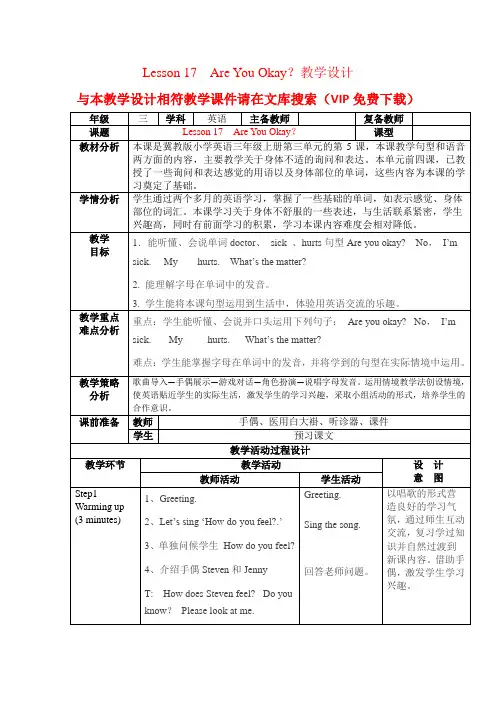
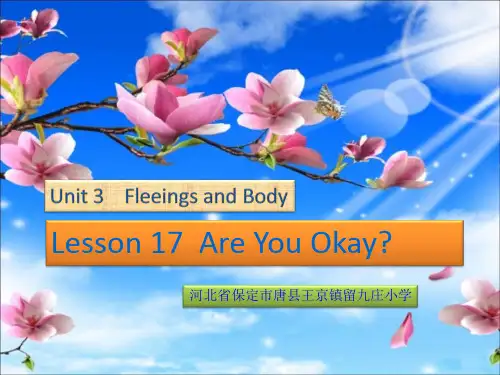
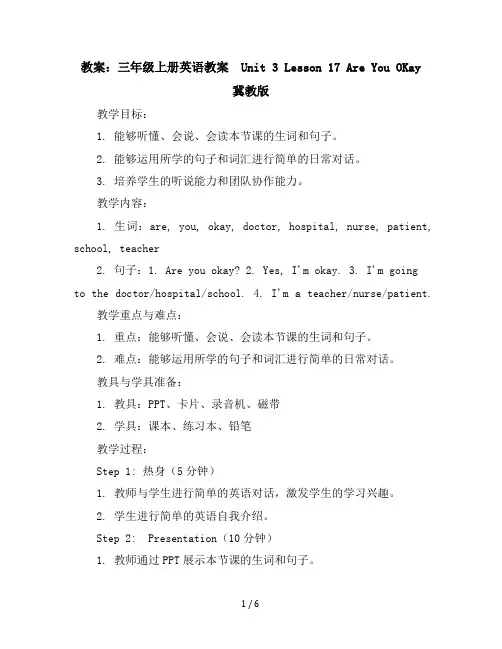
教案:三年级上册英语教案 Unit 3 Lesson 17 Are You OKay冀教版教学目标:1. 能够听懂、会说、会读本节课的生词和句子。
2. 能够运用所学的句子和词汇进行简单的日常对话。
3. 培养学生的听说能力和团队协作能力。
教学内容:1. 生词:are, you, okay, doctor, hospital, nurse, patient, school, teacher2. 句子:1. Are you okay? 2. Yes, I'm okay.3. I'm goingto the doctor/hospital/school. 4. I'm a teacher/nurse/patient.教学重点与难点:1. 重点:能够听懂、会说、会读本节课的生词和句子。
2. 难点:能够运用所学的句子和词汇进行简单的日常对话。
教具与学具准备:1. 教具:PPT、卡片、录音机、磁带2. 学具:课本、练习本、铅笔教学过程:Step 1: 热身(5分钟)1. 教师与学生进行简单的英语对话,激发学生的学习兴趣。
2. 学生进行简单的英语自我介绍。
Step 2: Presentation(10分钟)1. 教师通过PPT展示本节课的生词和句子。
2. 教师用英语解释生词和句子的意思,并用中文翻译。
3. 学生跟读生词和句子,教师纠正发音。
Step 3: Practice(10分钟)1. 教师将学生分成小组,每组学生相互练习对话。
2. 教师巡回指导,纠正学生的发音和语法错误。
Step 4: Consolidation(10分钟)1. 教师组织学生进行角色扮演,运用所学的句子和词汇进行对话。
2. 学生展示自己的对话,教师给予评价和反馈。
板书设计:1. 在黑板上写出本节课的生词和句子。
2. 用不同的颜色标注生词和句子的重点部分。
作业设计:1. 抄写本节课的生词和句子,并翻译成中文。
2. 写一篇小短文,运用所学的句子和词汇。
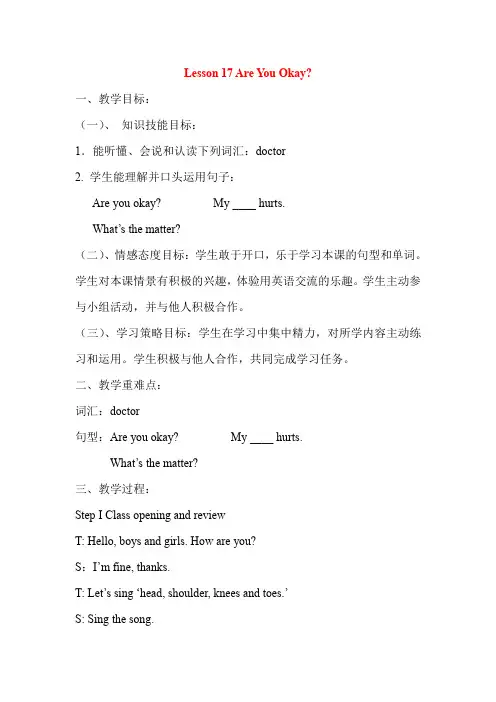
Lesson 17 Are Y ou Okay?一、教学目标:(一)、知识技能目标:1.能听懂、会说和认读下列词汇:doctor2. 学生能理解并口头运用句子:Are you okay? My ____ hurts.What’s the matter?(二)、情感态度目标:学生敢于开口,乐于学习本课的句型和单词。
学生对本课情景有积极的兴趣,体验用英语交流的乐趣。
学生主动参与小组活动,并与他人积极合作。
(三)、学习策略目标:学生在学习中集中精力,对所学内容主动练习和运用。
学生积极与他人合作,共同完成学习任务。
二、教学重难点:词汇:doctor句型:Are you okay? My ____ hurts.What’s the matter?三、教学过程:Step I Class opening and reviewT: Hello, boys and girls. How are you?S:I’m fine, thanks.T: Let’s sing ‘head, shoulder, knees and toes.’S: Sing the song.T: Good. How do you feel?T:…T: How does Steven feel? Let’s see.通过歌曲复习身体部位单词,通过问答复习表示各种感觉的词汇。
以问题引出本科内容。
Step II New conceptsPart 1: Are you okay?(1) Show the cartoon通过观看动画让学生了解本课要学内容。
T: How does Steven feel? He is sick.T: What’s the matter? His head hurts.引出sick, hurts.教师通过动作表情帮助学生理解其含义。
板书:Are you okay? No, I’m sick.What’s the matter? My ____ hurts.在学生理解意义的基础上,领读,做适当的动作。
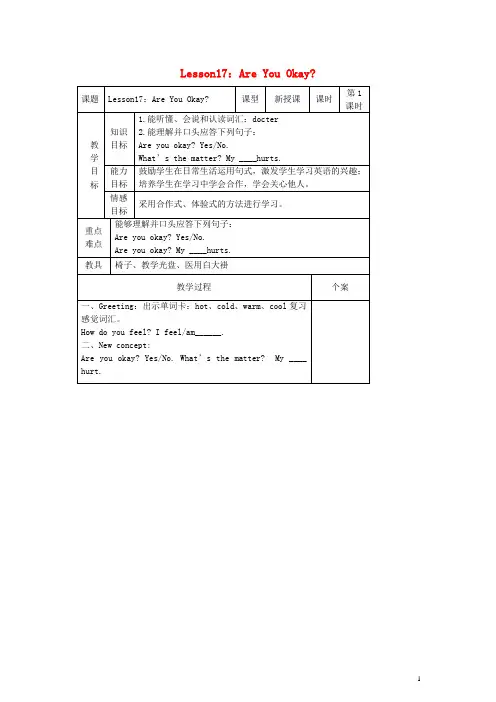
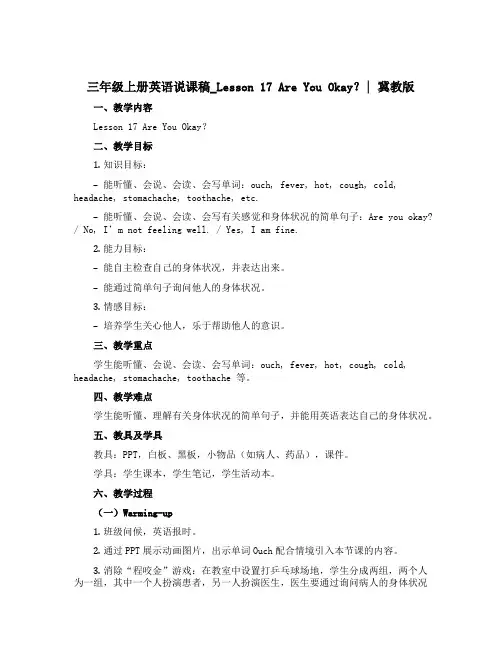
三年级上册英语说课稿_Lesson 17 Are You Okay?| 冀教版一、教学内容Lesson 17 Are You Okay?二、教学目标1.知识目标:–能听懂、会说、会读、会写单词:ouch, fever, hot, cough, cold, headache, stomachache, toothache, etc.–能听懂、会说、会读、会写有关感觉和身体状况的简单句子:Are you okay? / No, I’m not feeling well. / Yes, I am fine.2.能力目标:–能自主检查自己的身体状况,并表达出来。
–能通过简单句子询问他人的身体状况。
3.情感目标:–培养学生关心他人,乐于帮助他人的意识。
三、教学重点学生能听懂、会说、会读、会写单词:ouch, fever, hot, cough, cold, headache, stomachache, toothache 等。
四、教学难点学生能听懂、理解有关身体状况的简单句子,并能用英语表达自己的身体状况。
五、教具及学具教具:PPT,白板、黑板,小物品(如病人、药品),课件。
学具:学生课本,学生笔记,学生活动本。
六、教学过程(一)Warming-up1.班级问候,英语报时。
2.通过PPT展示动画图片,出示单词Ouch配合情境引入本节课的内容。
3.消除“程咬金”游戏:在教室中设置打乒乓球场地,学生分成两组,两个人为一组,其中一个人扮演患者,另一人扮演医生,医生要通过询问病人的身体状况来判断病情,从而为病人进行医治。
比赛过程中,双方要边打乒乓球边进行角色扮演活动。
(二)Presentation1.呈现单词:fever、hot、cough、cold、headache、stomachache、toothache 等单词。
2.向学生介绍单词hot、cold及其用法,并通过PPT展示相关图片。
3.教师出示图片,向学生介绍其他单词及其用法。
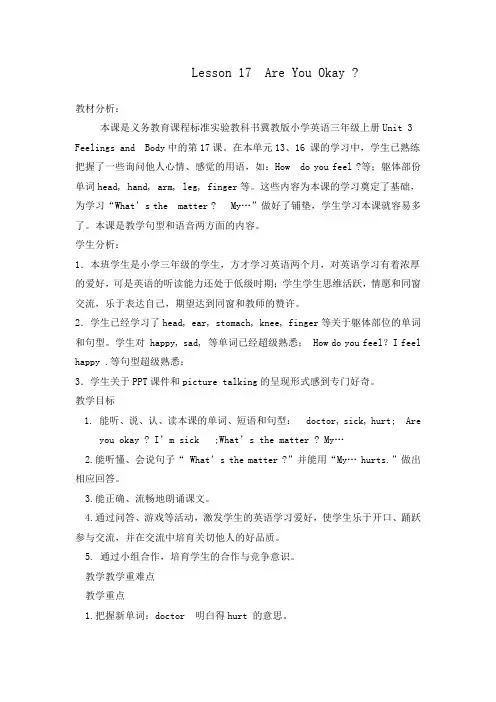
Lesson 17 Are You Okay ?教材分析:本课是义务教育课程标准实验教科书冀教版小学英语三年级上册Unit 3 Feelings and Body中的第17课。
在本单元13、16 课的学习中,学生已熟练把握了一些询问他人心情、感觉的用语,如:How do you feel ?等;躯体部份单词head, hand, arm, leg, finger等。
这些内容为本课的学习奠定了基础,为学习“What’s the matter ? My…”做好了铺垫,学生学习本课就容易多了。
本课是教学句型和语音两方面的内容。
学生分析:1.本班学生是小学三年级的学生,方才学习英语两个月,对英语学习有着浓厚的爱好,可是英语的听读能力还处于低级时期;学生学生思维活跃,情愿和同窗交流,乐于表达自己,期望达到同窗和教师的赞许。
2.学生已经学习了head, ear, stomach, knee, finger等关于躯体部位的单词和句型。
学生对 happy, sad, 等单词已经超级熟悉; How do you feel?I feel happy .等句型超级熟悉;3.学生关于PPT课件和picture talking的呈现形式感到专门好奇。
教学目标1.能听、说、认、读本课的单词、短语和句型: doctor, sick, hurt; Areyou okay ? I’m sick ;What’s the matter ? My…2.能听懂、会说句子“ What’s the matter ?”并能用“My… hurts.”做出相应回答。
3.能正确、流畅地朗诵课文。
4.通过问答、游戏等活动,激发学生的英语学习爱好,使学生乐于开口、踊跃参与交流,并在交流中培育关切他人的好品质。
5. 通过小组合作,培育学生的合作与竞争意识。
教学教学重难点教学重点1.把握新单词:doctor 明白得hurt 的意思。
2.把握表述“关切、问候他人健康状况”的用语。
教案:冀教版英语三年级上册:Lesson 17 Are You Okay?教学目标:1. 能听懂、会说、会读本课的生词和句子。
2. 能用英语询问他人的状况,并能用简单的句子回答。
3. 能通过情境交际,运用所学知识进行日常交流。
教学内容:1. 生词:Are you okay? I'm okay. What's wrong? He's okay. She's okay. We're okay. They're okay.2. 句子:Look! They are okay. Are you okay? Yes, I'm okay. What's wrong? He's okay. She's okay. We're okay. They're okay.教学重点与难点:1. 重点:掌握询问他人状况的句子和回答。
2. 难点:能够正确运用所学生词和句子进行日常交流。
教具与学具准备:1. 教具:PPT、卡片、录音机、磁带。
2. 学具:课本、练习册、铅笔、橡皮。
教学过程:Step 1: 热身(5分钟)1. 教师与学生用中文进行简单的日常交流,如问候、询问身体状况等。
2. 学生自由交谈,熟悉课堂氛围。
Step 2: 引入(10分钟)1. 教师播放Lesson 17的录音,让学生听懂并跟读。
2. 教师出示生词卡片,引导学生朗读并理解词义。
Step 3: 课堂讲解(10分钟)1. 教师讲解生词和句子的用法,让学生进行模仿练习。
2. 教师创设情境,让学生用英语询问他人的状况,并用所学句子回答。
Step 4: 小组活动(10分钟)1. 学生分成小组,用英语进行角色扮演,模拟情景交际。
2. 教师巡回指导,纠正学生的错误,并给予鼓励。
2. 学生回答问题,巩固所学知识。
Step 6: 作业布置(5分钟)1. 教师布置作业:抄写生词、句子,并进行情景交际练习。
教案:三年级上册英语教案_Lesson 17 Are You Okay?|冀教版教学目标:1. 能够听懂、会说、会读本课的生词和句子。
2. 能够用英语询问他人的状况并回答。
3. 能够用英语简单描述日常生活中的意外情况并寻求帮助。
4. 培养学生的观察能力和表达能力。
教学内容:1. 教学单词:fall down, hurt, help, okay, doctor, hospital。
2. 教学句子:1. Are you okay? 2. Yes, I'm okay.3. No,I'm not okay. 4. Please help me. 5. Call a doctor. 6. Go tothe hospital.教学重点与难点:1. 重点:单词fall down, hurt, help, okay, doctor,hospital和句子的运用。
2. 难点:句子结构的运用和描述日常生活中的意外情况。
教具与学具准备:1. 教具:课件、图片、卡片。
2. 学具:课本、练习本、文具。
教学过程:Step 1: 热身(5分钟)1. 教师与学生用英语进行简单的问候和交流。
2. 学生表演日常生活中的动作,如:fall down, hurt, help等,教师进行点评和指导。
Step 2: 引入(10分钟)1. 教师向学生展示图片,引导学生用英语描述图片内容。
2. 教师引导学生思考并讨论在日常生活中遇到意外情况时应该如何寻求帮助。
Step 3: 呈现(10分钟)1. 教师通过课件展示本课的生词和句子。
2. 教师用卡片游戏的方式让学生练习单词和句子的发音和拼写。
Step 4: 操练(10分钟)1. 教师组织学生进行角色扮演,模拟日常生活中的意外情况,并用英语进行交流。
2. 学生分组进行练习,教师进行巡回指导。
Step 5: 巩固(5分钟)1. 教师给出情景,学生用英语描述并提出解决方案。
2. 学生互相交流并分享自己的经历。
三年级上英语教学设计-Lesson 17 Are You Okay-冀教版一、教学目标1. 知识与技能目标1.了解日常用语“Are you okay?”的表达方式。
2.掌握日常用语“Are you okay?”的应答方式。
3.通过教学,提高学生的语言思维和口语表达能力。
2. 情感态度与价值观目标1.培养学生热爱学习英语的兴趣。
2.培养学生关心他人、尊重他人的价值观。
二、教学重难点1. 教学重点1.日常用语“Are you okay?”的表达方式。
2.日常用语“Are you okay?”的应答方式。
2. 教学难点语音语调的准确使用,以及应对复杂应答的技巧。
三、教学准备录音机、课件、PPT、黑板、白板、课本。
四、教学过程1. 导入(5分钟)教师出示包含“Are you okay?”的图片,让学生看图片并自由表述。
2. 新课讲解(15分钟)1.教师通过PPT或黑板,出现“How do you feel today?”然后以问答的方式,引导学生自学“How are you?”。
2.通过PPT或黑板,展示How are you? 和I’m fine. / Not bad. / OK.的句子,让学生模仿发音并反复练习。
重点讲解英语短语I’m fine. / Not bad. / OK.。
3.通过PPT或黑板,出现Are you okay? 和Yes, I am. / No, I’m not. + 原因的句子。
让学生强化记忆。
重点讲解“Yes, I am.”和“No, I’m not.”的句型及相应的应答。
3. 课堂练习(20分钟)1.情景模拟。
教师创造三种情景,学生运用所学单词和短语进行对话。
•一、一位学生不舒服,另一位学生询问病情。
•二、学生之间问候打招呼。
•三、学生之间相互关心、询问近况。
2.通过录音听力练习。
播放录音,让学生听录音并做出应答。
4. 课堂小结(10分钟)1.通过学生课堂练习情况,复习Yes, I am 和No, I’m not语句。
冀教版英语三年级上册: Lesson17 Are You Okay 说课稿一、教材分析本节课是冀教版英语三年级上册的第17课,名为 Are You Okay。
本课旨在让学生掌握关于身体部位的单词及它们的表达方式,能够用英语向他人表达自己或他人的健康状况。
本课通过简单的问候和回答方式,让学生在语言中了解乐于助人、互相关心的重要性。
二、教学目标•能正确听、说、认读 head, shoulders, knees, toes, eyes, ears, mouth, nose, stomach等单词;•能用简单的英语询问和表达疼痛的部位,例如 Are you okay? Is your head okay? My nose hurts, 等;•能理解道谢和帮助的表达方式,例如Thank you. You’re welcome.等。
三、教学重难点•教学重点:让学生掌握单词,能够用英语表达健康状况;•教学难点:运用英语表达身体部位。
四、课前准备•制作课件,加深学生对单词的印象;•准备一些图片,通过图片引入单词;•制作一份小练习,检验学生对课前内容的掌握情况。
五、教学步骤1. 首先向学生讲述今天的主题今天我们将要学习表示身体部位的单词,像头、肩膀、膝盖、脚趾、眼睛、耳朵、嘴巴、鼻子、胃等等。
我们将通过简单的问候和回答方式,学习用英语询问身体健康状况以及向他人表达道谢和帮助。
2. 引入单词通过图片向学生展示不同身体部位的图片,让学生模仿老师或录音机的读音,逐个学习这些单词:head, shoulders, knees, toes, eyes, ears, mouth, nose, stomach。
3. 练习用英语表达身体部位教师将身体部位单词逐个展示在课件上,通过图片引导学生回答问题。
例如:Where is your head? Where are your shoulders?4. 练习用英语询问健康状况老师示范用英语询问健康状况,例如:Are you okay? Is your head okay? My nose hurts. Are your toes okay? 然后让学生模仿老师的问话和回答,互相练习。
小学英语三年级上册Unit 3 Lesson 17 Are You Okay 教案冀教版三起教材分析:本课是小学英语三年级Unit 3 Lesson 17 Are You Okay 课。
该课是本单元的最后一课,主要教授学生在紧急情况下的求助方式,让学生能够用英语表达自己遇到紧急情况时的求助话语,增强学生的安全意识和应变能力。
教学内容简单易懂,符合小学生的认知水平和学习特点,教材选材生动有趣,能够引导学生在愉悦中学习,有利于提高英语学习的兴趣。
教学目标:1. 能听懂、会说、会读、会写本课的生词和短语:call, doctor, help, hurt, sick, ambulance。
2. 能够理解和运用本课重点句型及交际用语:Are you okay? I’m sick. Can you help me? Call a doctor.3. 能够通过学习本课的内容,提高学生的安全意识,能够在紧急情况下正确地求助。
4. 学生通过做游戏、听录音、角色扮演,巩固学习内容,开发学生的英语听、说、读、写能力。
教学重点:1. 能够理解并掌握本课所学的词汇和交际用语。
2. 能够在学习中提高学生的口语表达和听力理解能力。
教学难点:1. 能够在玩游戏、角色扮演等情境下,培养学生的英语口语表达能力。
2. 能够在生活中灵活运用所学的语言表达和应对意外情况。
教学过程:Step 1:导入1,通过图画或彩蛋游戏,介绍本课的主题:紧急情况求助。
2,教师出示生词卡片:call, ambulance, hurt, help, doctor, sick,并引导学生正确地读、写和说出这些单词。
Step 2:新课讲解1,播放录音,让学生听读重点词汇和短语。
2,教师出示课文的图片或挂图,引导学生理解和掌握课文内容。
3,结合图片或材料,向学生解释重点交际用语。
Are you okay? I’m sick. Can you help me? Call a doctor.4,模拟提问和回答,让学生发言练习。
小学英语冀教版三年级上册Unit 3 Feelings and Body《lesson17 Are You OKay》公开课优质课教案比赛讲课获奖教案1教学目标1.通过课堂学习活动,学生能准确的识记nose,ear.2.通过情景的创设和小组合作学习,学生能在语言情境中体会并使用语句Are you okay?No.My nose/ knee hurts.3.通过课堂表演,学生能大胆自信地运用英语进行交流,培养正确的身体部位意识,提高学生的学习兴趣,调动学生学习的积极性。
2学情分析四年级学生活泼好动,善于模仿,乐于参与活动,喜欢积极表现自我。
思维以形象思维为主,主要是依靠直观的、具体的内容。
他们的记忆强度不大,注意力保持时间短,有一定的观察能力,他们需要的是能够与他们“玩”到一起的老师,需要在趣中求学。
经过四年的学习,对英语已有初步认知,有一些英语基础,因此教师要设计学生喜欢的活动让每一个学生都参与进来。
3重点难点1.理解认知本课词汇及句子2.会表达我的鼻子,耳朵,膝盖疼的句子。
4教学过程教学活动1【导入】11:Warm - up (1 mintues)1.Greetings问好:How are you ?I am fine.Nice to meet you.Let’s sing a song!(If you are happy and you kn ow it,clap your hands.)Let’s watch the movie.2【讲授】2Step2:Presentation(新知呈现)(20 minutes)1. (1 minute)播放学生自己录的微课,(上课前学生自己的录像关于nose,leg,ear hurts)微课内容是:学生在课间玩投掷游戏,“I hurt my leg.”主角说:“Are you okay?”“No.”同伴忙帮助找学校医生,医生问“Are you okay?”“”主角说”No,I hurt my foot.”两位医生说:“Let me see.I can help you.”第二个学生伤到耳朵,来到医院,医生询问情况。